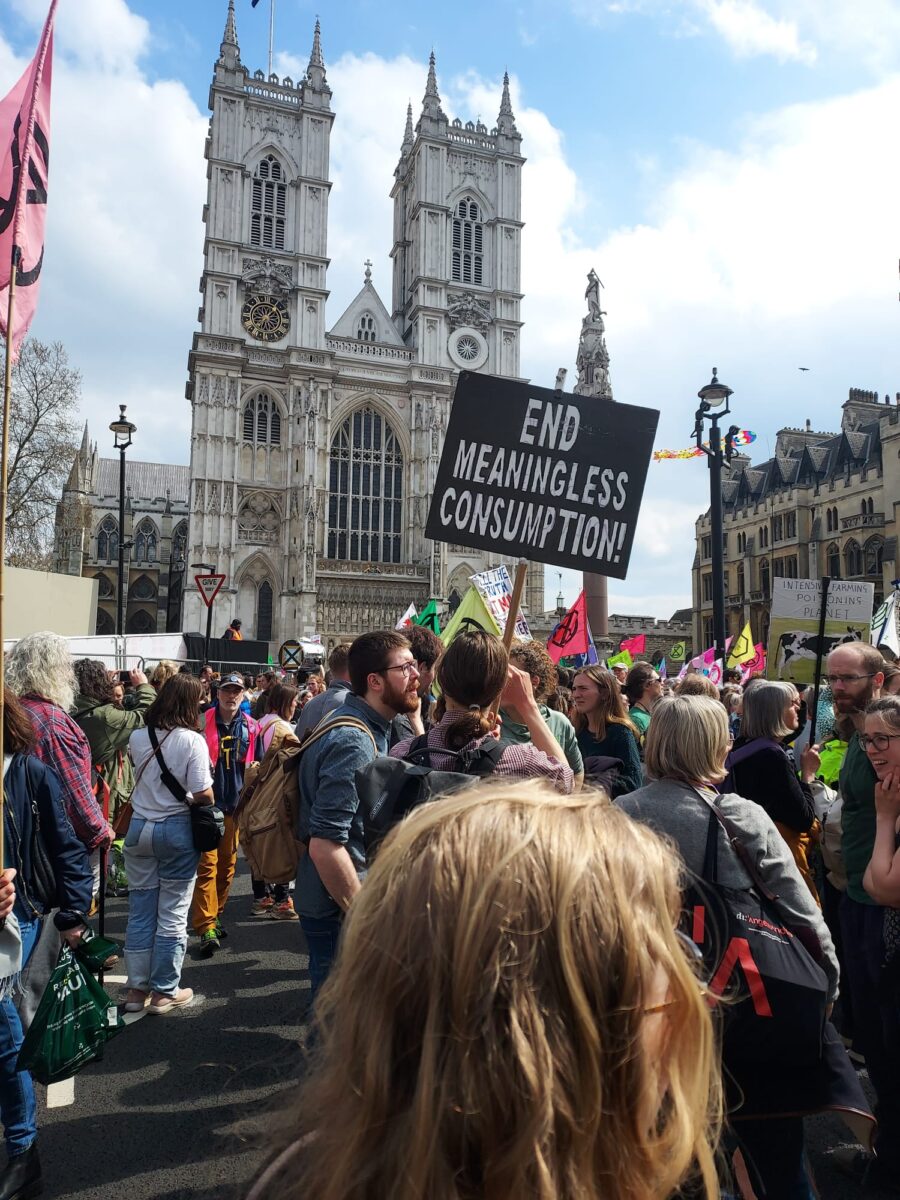The demo felt, looked, and sounded a lot different than most left, trade union, or campaign ones you have been on for years. For a start, the age demographic was much more evenly spread. Lots of families marched with their children, big or small. In many left demos, there is a big shortage of people between the ages of 25 and 60.
It looked a lot different too—many people had dressed as animals to reflect the biodiversity message. A large majority of the placards and banners were homemade and not mass-produced by radical left groups. You could spend all afternoon taking pictures of the creative slogans and placards (see the photo essay on this site to get an idea of this). Indeed, there seemed to be just a token presence of the bigger left groups at this demonstration. I did not see the usual army of newspaper sellers. Hardly any trade union or Labour Party banners either.

Certainly, in terms of numbers, the XR rebellion reached its target. They had talked before about getting 30,000 people out on the streets, and that looked like a credible number to me. If you factor in that the events carried over three days, then the so-called turn XR has made to unify with more organisations in action and to pause or lessen their direct action disruption appears to have paid off. It looked to me like they managed to bring out a significant number of Green Party members and voters, as well as new people.
As Andreas Malm and others have pointed out, most historic mobilisations, including the successful ones, tend to have a radical flank that overall has a positive effect on the movement. So, for example, in the American Civil Rights movement of the 1960s, the non-violent mass protests led by Martin Luther King went alongside the riots, the Black Power movement, and the armed self-defence of the community. All parts of the movement contributed to the gains made.


I noticed that the radical lawyer that spoke started out by calling for a cheer of solidarity with the two eco-activists now starting repressive jail terms for climbing on motorway bridges. It got a good response. The rank and file of the eco movement certainly value that kind of sacrifice, even though not everyone can make it.
I was also impressed by the organisational capacity of the XR comrades; there were hundreds of stewards, and things went smoothly. Although newer allies did not necessarily bring big battalions on the march, there were speakers from Black Lives Matter, the trade unions, the Green Party, and the Labour Party. Non-governmental organisations and lobby groups like Greenpeace were much in evidence, as were progressive religious groups.
The atmosphere was one of joy and hope, despite the dire dangers of climate change. One favourite chant was ‘This is what democracy looks like’. Some of the political ideas were a bit fuzzy, like the speaker’s support for citizens’ assemblies selected by lottery. As though you can create some sort of pure space outside of politics and politicians. However, it also expresses a revulsion against the sorry state of the political system.
Comrades from ACR reported that there was a lot of interest in our specially prepared broadsheet, and people wanted to stop and discuss with us. It is not so difficult for people coming out on Saturday to see the links between a government holding back nurses’ pay and one continuing to open coal mines or distribute oil and gas licences for more extraction. The same cover-up we saw with ‘Partygate’ is seen with the secrecy about the privatised water companies spewing sewage into our rivers and seas.
Going forward, there is still a lot of work to do to create the necessary unity between the labour movement and ecological mobilisations, although clearly many of the people marching will have been involved as strikers in the ongoing wave of struggles in defence of our living standards. The need to have an eco-socialist perspective applies to both the mainstream and radical wings of the labour movement. Large-scale demonstrations like these will help break down barriers and increase the credibility of eco-activists.
Art Book Review Books Campism Capitalism China Climate Emergency Conservative Government Conservative Party COVID-19 Creeping Fascism Economics EcoSocialism Elections Europe Far-Right Fascism Film Film Review Fourth International France Gaza History Imperialism Iran Israel Italy Keir Starmer Labour Party Long Read Marxism Marxist Theory Migrants Palestine pandemic Police Protest Russia Solidarity Statement Trade Unionism Ukraine United States of America War Women
Latest articles
- Your Party Founding ConferenceFind all the key information from Anti*Capitalist Resistance for the Your Party Founding Conference. Below is the rolling blog for updates throughout conference.
- We need to talk about the Labour PartyDave Kellaway reviews and discusses the issues raised by The Starmer Symptom edited by Mark Perryman and published by Pluto Press, 2025
- Marxist Rhetorical Strategy in the Communist ManifestoAhead of the publication of The Enduring Communist Manifesto by Resistance Books, Twilight O’Hara looks at how Karl Marx and Friedrich Engels use rhetoric in this pamphlet.
- In Solidarity with Refugees and MigrantsMigrants and refugees are not our enemies, but are being used by the powerful to distract from the real cause of social injustice. Susan Pashkoff writes against this moral panic.
- COP30: The shift to green capitalism fails to materialiseChristian Zeller explains how despite dramatic warning signs, global politicians continued to back the fossil fuel-based economic order







I agree with Dave’s comment about citizen’s assemblies as currently formulated by XR.
For XR politics largely means party-politics. In its place it argues for the creation of Citizen’s Assemblies randomly selected in a similar way to jury service.
The idea is that they will be fully representative, not beholden to political parties, lobbies or interest groups. They will listen to best science and agree on what is to be done.
But there is a problem here in that such an assembly is made up of isolated individuals. It is not self-organised and has no democratic mandate from the grassroots. As such it is prey to the hostile mass media and their framing of the possibilities, choices and alternatives. Having neither legislative nor executive powers the danger is that a Citizen’s Assembly would be merely a consultative body or focus group.
This, then, points to a need for an ongoing popular movement, in parallel with any assemblies which are set up, in order to prevent them being recuperated to serve the interests of fossil capitalism or provide a bit of greenwash.
So, yes to citizen’s assemblies but we might argue that they be delegate bodies built from the grassroots up. Local assemblies feeding into higher bodies with real powers to formulate and agree policy and oversee its implementation.
The assemblies should also contain representatives of workers in key industries and sectors. This cannot be left to the chance of a random ‘sortition’ method. This is important not just to manage the transition to zero carbon but to harness the skills, creativity and inventiveness of large numbers of people in key industries who have transferable skills for a zero carbon economy.
The experience of the Lucas Plan of the 1970 holds important lessons here with its pioneering work in workforce led planning for alternative production.